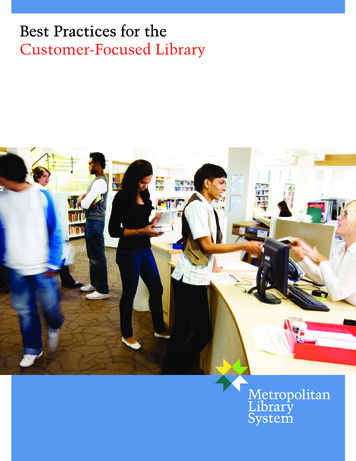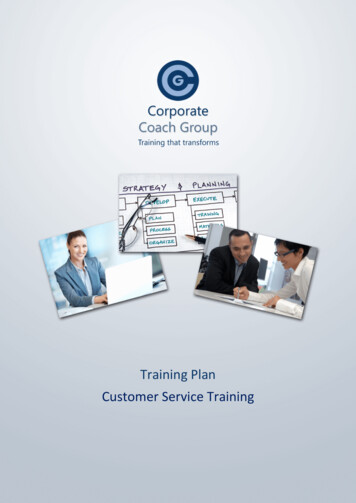
Transcription
Best Practices for theCustomer-Focused Library
Best PracticesSummaryThis Customer Focused Library grant was designed tostudy library services and service attitudes from a retailperspective. Best practices from retail were appliedto library space utilization, service philosophy, andservice visibility. The consultants hired for this projectevaluated the ways in which our libraries serve theircustomers, with the goal being the development of acustomer-focused service model for member libraries.ResearchObjectives Explore the dynamics of visitorbehavior at four Chicago arealibraries, including both public andacademic libraries. Measure visitor interactions attouch points in the library. G enerate information on howpublic and academic libraries inthe Chicago area can better serviceand educate their visitors, therebycreating a more satisfying library visit.ResearchMethodologyFour libraries in the Chicago area werestudied for two days each, utilizing acombination of observation, interviewsand video.AttitudinalObservational Tracking: Researchers usedmapping programs to track andtime customers’ movements andinteractions within the library.424 visitor groups were observed infour Chicago area libraries Q uestionnaires: Library patronswere intercepted after their visitto the library to inquire abouttheir experience in the library andthe services which they regularlyuse. Patrons were offered a gift forcompleting the questionnaire.267 patrons were interviewed aftertheir library visitVideo S mall video cameras were installedin key areas of the librariesin order to capture behavioralpatterns, traffic flow, wait times andtransaction times.Over 750 hours of video footage weregenerated for analysis
Best PracticesFindingsVisitor Profile 95% visited once per month, overhalf visited once per week, and themajority visited alone. 5 6% spent less than 10 minutesin the library, a surprising findingmore typically associated withbookstores and grocery stores. T wo-thirds did not know whatthey wanted before they arrived.Since patrons may not come to thelibrary with a specific “need,” wehave an opportunity to appeal totheir “wants.”Key finding:People already in the library are a primary target for items andservices. The fact that a large percentage visited alone indicatesan openness to ‘product’ placement and service pitches. Theshort length of time indicates the need for a simple, easilytransmitted message.Key finding:Audiovisual materials accounted for 1/3 of circulating items.In retail, alone visitors are either missionoriented or are more open to messages thancouples. Break through the “forcefield” ofThese items should be positioned in a browsable collection,particularly where patrons encounter a wait. Patrons aged 14-24are particularly drawn to AV.personal space to deliver the message.Fewer than one in tenpatrons aged 14-24visited the Books section80%The Future70%The Percentage of Patronsin Each Age Group WhoVisit Each Section TypeThe Past60%Audio Visual c Areas20%ServicesRooms10%0% 14 [n 11] 14-17 [n 12]18-24 [n 111]25-34 [n 48]35-44 [n 76]45-54 [n 63]55-64 [n 52]65 [n 51]
Visitor Behavior O ne-third of patrons visited a deskas their first destination. A ge impacted the sections of thelibrary visited by patrons. Youngerpatrons used the computersand seldom visited sections withcirculating materials. Older patronswere less likely to use the computersand self-check. H ighest impact services werecirculation (60%), internet access(18%), online library catalog use (15%)and reference services (15%). T wo-thirds of patrons were using thelibrary for reading or conversation,and 15% of weekly visitors neverborrow from the library. H alf of patrons pulled an item off theshelf while browsing, with more itemspulled in AV collections. 7 0% of patrons checked out books,51% checked out AV materials.Key finding:Patrons are seeking staff interaction to serve their needs.Staff must be available and willing to help, no matter whatdesk patrons seek.Messages near, not on, desks are agood way to gain visibility. Place signswhere your patrons are, not whereyou expect them to be.Key finding:Diversify material types to meet more patron needs. Patronsshort on time may prefer a movie to a book, and those withcommutes may prefer audio books as opposed to print.Key finding:Selection and assortment of material wasthe lowest ranked category on services. ThisIf patrons are browsing materials, collections must bebrowsable. It’s easier to change to fit patron needs than it isis a difficult issue that retail environmentsto retrain them. Communicate sections in common languagealso face – you may have the item, but theinstead of solely relying on call numbers to guide browsing.patron may not be able to find it.Key finding:Patrons are utilizing the library as meeting and study space, notjust for items, computers or services. Allotting space for studyand socializing needs is important when creating an overallatmosphere of service. Patrons using the building are easier toconvert to users of library services than those who do not enter.
Best PracticesFindingsAssistance Over half of patrons, excludingcirculation transactions, wereobserved receiving assistance ofsome kind. Finding items on the shelf causedthe greatest need for assistance,followed by finding the right section.Less than 15% of patrons neededhelp with guiding research, explainingservices, and recommending items. B etter directional/explanatorysignage would alleviate observedneed for finding sections and freestaff time.Key finding:Staff trained to offer assistance in more efficient browsingand research may be a better use of personnel than stationingAssistance rates were significantlyhigher (60% on average) in this studycompared to previous library studiesat desks. A more visible staff identification would similarlyhelp patrons find assistance when needed while away fromformal desks.(13%) and retail environments (15%).Frankfort Density MapThe density of patronsnear the computersindicates thesurrounding area willfeel the effects of thenoise. Clearly designatea “Quiet Area” atFrankfort to accomodatepatrons who need toconcentrate.Library ActivityComputersReadingConversingPlayingUsing a rary StaffSource: Observation34%30%6%2%1%
Signage Only 12% of patrons viewed librarysignage. Patrons aged 45-64 weremost likely to view signs, with 34 andunder least likely. Stacks signage was viewed by45% of people who viewed signs.Key finding:Utilize unusual places to advertisethe library’s website and otherservices: screensavers, receipts,Signage is the greatest tool to connect patrons with materials,either by indicating sections or introducing patrons to newauthors. Easily changed, attractive signage in highly visibleareas produces the most impact.check-out lines, etc.Key finding:Desk surfaces are not the best location for collateral andsigns. The patron waiting can’t see them, and the personwho is engaging with library staff doesn’t need them.Consider an attractive central collateral station instead thatleaves surfaces clear.Key finding:Sightlines and sign positioning were the most commonsymptoms of poor signage. Move through the library todetermine patron flow and best positions for signage.
Best PracticesSolutionsMarketResourcesEffectively Provide strategic links to the onlinecatalog, and use catalog tools tolead users to additional items. Bring images into the space tocreate a more visually stimulatingenvironment.Consider ways to work within the DeweyDecimal System in order to free up howbooks are displayed. Face out morebooks to take advantage of cover art andincrease capture power. O ffer more ways to pair patronswith materials. Best Sellers, NewReleases and a designated areafor Staff Recommendations are agood start.Email lists with updates on NewReleases, Best Sellers and Hot Topicsare a good way to reach out to patronswhile they are not at the library. E xpand the Audio Visual sectionboth in terms of the amount of spaceallocated to the section as well asthe materials carried.Consider adding console games andother new technologies that combinelearning with entertainment. Group all AV materials together(Music CDs, DVDs/Videos and AudioBooks) and position the section closeto Circulation to encourage impulseborrowing.Consider placing AV materials for allages in the same location, rather thanhaving separate Children’s and Teen’ssections, thus creating a “store-withina-store” concept. Change displays frequently,at least monthly or even weekly,to re-capture patron’s attention,based on frequency of library visits.No Budget?Low Budget?High Budget? W eed collection tomake room forface-out. Identify andmarket staffrecommendations. Use screensavers anddesktop wallpaper tomarket services. P rovide “while youwait” booklists forbest sellers. U se shelf ends todisplay materials. Purchase displayshelving to face outmaterials.
Orient Yourselfto PatronConvenience Coach your responses at the firstvisited desks to be service-focused.Often the desk closest to the door iswhere the most questions are askedand where a service impressionis formed. Look at signage with a patron’seye – check sightlines, proximityto wait/traffic areas, and removejargon. F ace-out shelving makes retrievalslightly more difficult, butdramatically increases circulation.Consider sacrificing quantity forquality in face-out arrangements. Create a large site map for eachlibrary and clearly identify sectionson both the map and throughsignage, preferably in view fromthe map location. F ind ways to extend service beyondthe desk, and get to where yourpatrons are.Face-out children’s books at Frankfortcirculated 40% more than when shelvedtraditionally. Space concerns arealleviated by frequency of circulation.Position the map near the onlinecatalogue to enable patrons to look upspecific items or browse by section.No Budget?Low Budget?High Budget? A pproach patronsto see if they needassistance. Spend time observingpatrons to noteconfusion points andbottlenecks. Clean service desksand encourage staff toengage with patronspassing desk areas. R efocus staff andservices on patronconvenience throughupdated policies,practices, and staffplacement. P urchase servicefurniture thatencourages patronengagement andminimizes barriersbetween staff andpatrons. C onduct servicetraining to focus staffon patron needs atand beyond the desk.
Best PracticesSolutionsUse SpaceCreatively G roup computer workstations,lounge seating and periodicals tocreate a “waiting area” for patronswho are waiting for a computer tobecome available. Consider how your space is used.Allow for gathering and loud spacesas well as quiet spaces. Create“buffer” zones between high-trafficand quiet study spaces. Little-used collection areas canbecome your new power walls.Move or remove collections to makespace for new arrangements. I nvestigate flexible signageand fixture packages for futurerenovations or new libraries thatenable easy asset reallocation asindividual library needs evolve. R ecognize the unutilized orunderutilized spaces in the libraryand adjust the layout accordingly.Sections with little or no visitationshould be re-evaluated in terms ofnecessity, location and aisle space.When possible, condense these sectionsto add room in high-traffic areas. N ew fixtures should focus ondisplaying circulating materialsrather than storing the materials.This will facilitate cover art functioningas a sign.No Budget?Low Budget?High Budget? M ove existingfurniture to repurposeunderutilized spaces. C reate your owndensity maps todetermine high trafficareas for promotionand underutilizedareas to redesign. R epaint or refurnishselect areas. P urchase newfurnishing andfixtures that fit spaceneeds of patrons.
Use SignsEffectively Follow a Signage Hierarchy Use Signage StrategiesLevel One: Section Identification Text signage is visible from the mainpath through the library.Level Two: Theme Images are immediately accessibleinformation to the viewer; use themto convey the topics and content ofthe section. Theme signage should be visiblefrom outside the section in order toattract patrons.Level Three: Dewey Identification Keep the Dewey signage on the endsof the stacks, as patrons know whereto look for this information.Level Four: Shelf Talk Face out titles on the shelves, anduse framed easel signs to directreaders to similar titles. Remember that “less is more.” Make sure the sign matters. Keep it concise. P osition in-depth signage inwait areas. E nsure viewing signs from backto front. U tilize odd shapes and sizes. Create a sense of movement. T he most frequently-viewed signagetype should also be the mostuser-friendly. C omputer-generated signage mustbe kept fresh, or else it loses capturepower among frequent visitors.No Budget?Low Budget?High Budget? U tilize simple,colorful computergenerated signagethat gets the messageacross. U se office printingservices to createfoam-core signsdesigned in-house torefresh directional orface-out signage. H ave flexible,customizable signagecreated by signprofessionals. P urchase electronicsignage (i.e. LCDs)to maximizecustomization.
Looking Forward D on’t try to change people’sbehavior: identify it and design for it. Think outside the box for everything. L et go of sacred cows, includingmaterials, furniture and beliefs. Prepare staff for change. U se density maps to gatherinformation on space use and areasfor improvement. I f your focus is service, make surestaff are service focused. I f circulation is your primary point ofhuman contact, train circulation staffto be ambassadors for other services. Analyze service at your first pointof contact, often the desk closestto the door. Gain insight into patron wantsthrough multiple means. Look for small wins while breakingdown larger projects. Track yoursuccess through an overallbuilding plan. Involve new eyes: people outside ofthe library can give you incredibleinsights. Pick people carefully to notbe restricted by traditional views oflibrary services.Change is not easy: you will face frustrations withbudget and staff. It takes resources and planning, buta customer-focused library reaps dividends in satisfiedpatrons who return for additional services.The most pointed lessons we learn from retail are inexamining our staff behavior, updating our marketingpractices, and offering patron-oriented services.With our libraries demonstrated dedication to meetingpatron’s wants and needs, the Customer FocusedLibrary is achievable.Metropolitan Library System125 Tower Dr.Burr Ridge, IL 60527[866] 734-2004Envirosell Inc.907 Broadway, 2nd FloorNew York, NY 10010[212] 673-9100PartnersSally AndersonNorth Park University LibraryJamie BukovacIndian Prairie Public Library DistrictDetlev PanschFrankfort Public Library DistrictMary TuytschaeversAcorn Public Library DistrictFunding for this grant wasprovided by a Library Servicesand Technology Act (LSTA)grant from the Illinois StateLibrary and the IllinoisSecretary of State.
patrons used the computers and seldom visited sections with circulating materials. Older patrons were less likely to use the computers and self-check. Highest impact services were circulation (60%), internet access (18%), online library catalog use (15%) and reference services (15%). Two-thirds of patrons were using the











